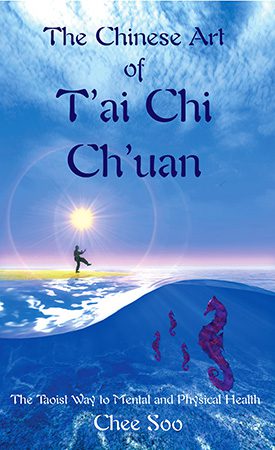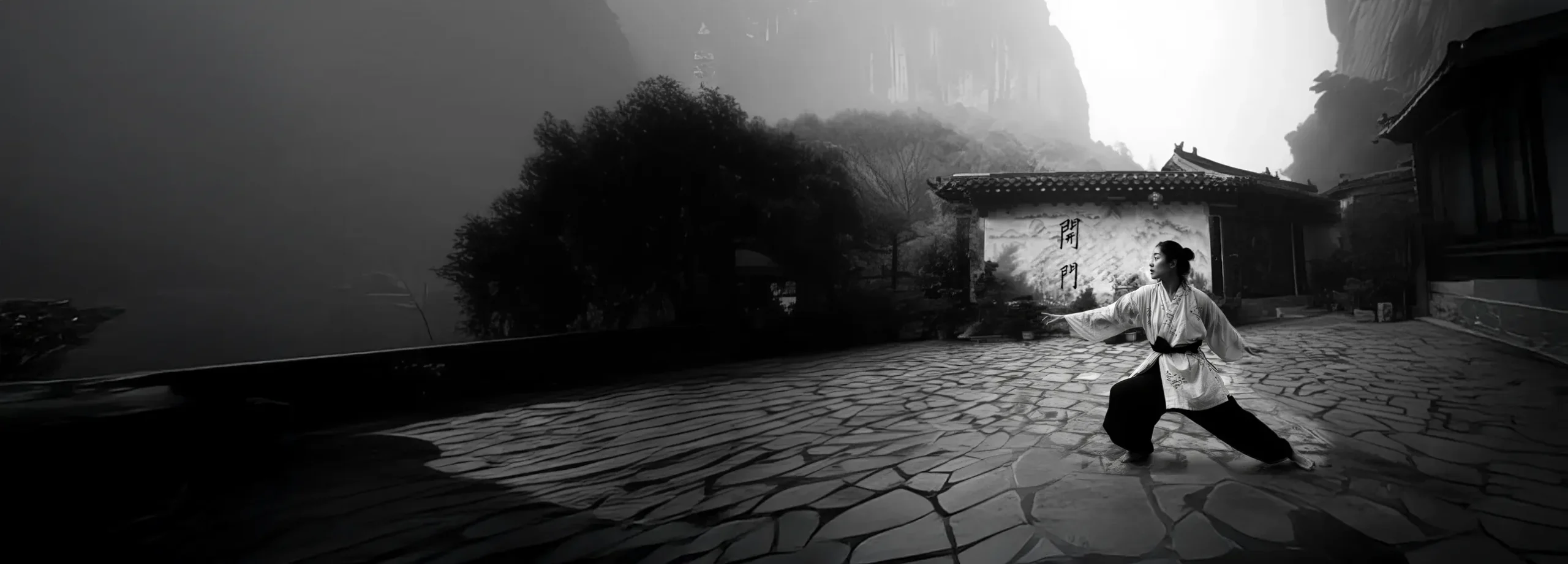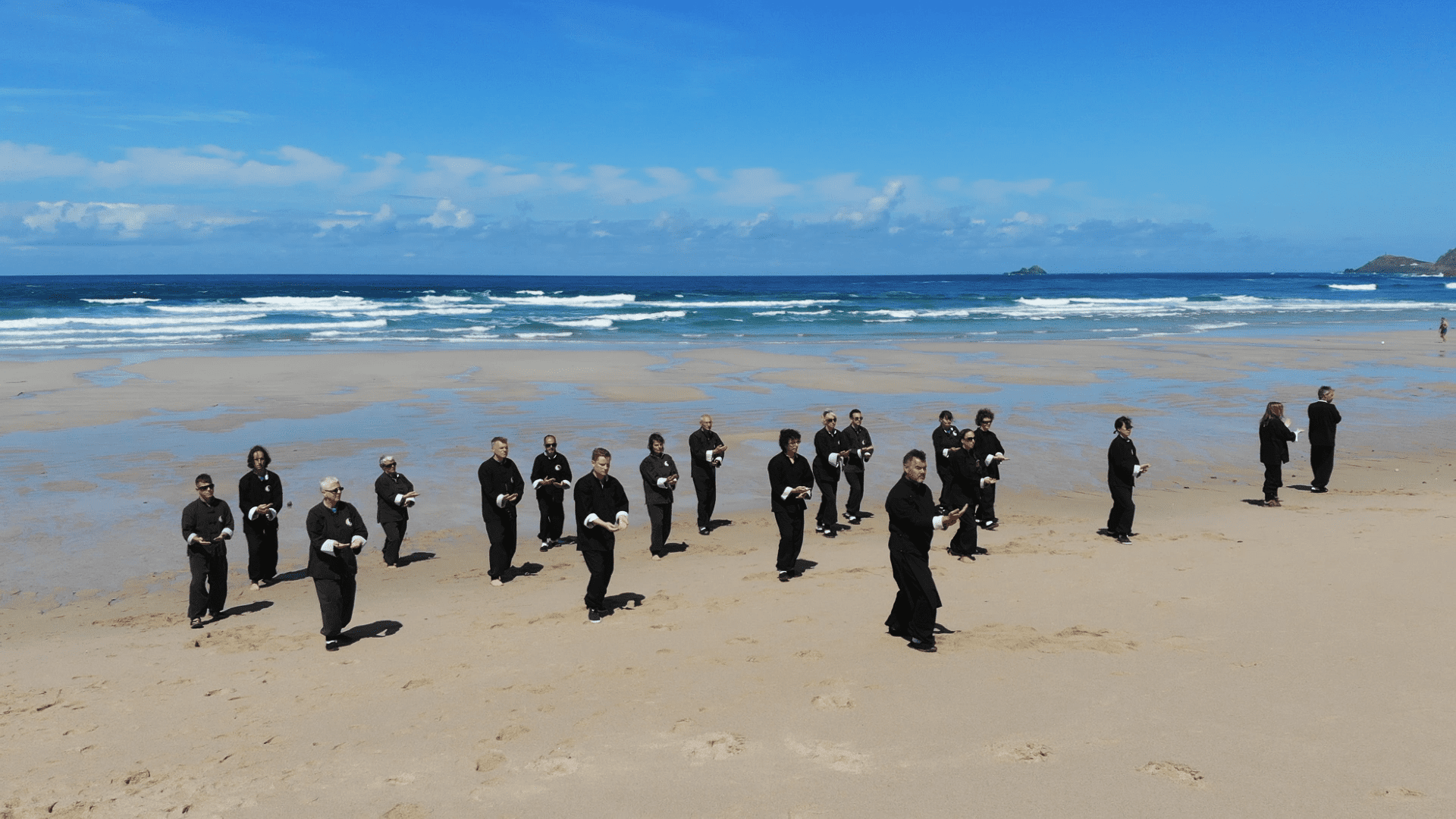Chapter 4
The Aims Towards Perfection
The author of this book has been practising T’ai Chi Ch’uan for sixty years, and knows deep down inside that even though others may think what you do is perfect, something you feel and appreciate can continue to be understood ever more deeply as time goes on. Yes, perfection is a word that has no boundaries, for only you can fix the limit of yourself. However, from my own personal experience and from the foundations created by my own master, let me pass on a few tips that will help you in your training and practise, because your teacher cannot watch or be near you all the time during your endless search to become better and better.
The Supreme Ultimate
For the truly dedicated person this is the ultimate goal pointed out to us by the Taoists of ancient China, and from my own personal experience I know it is true. In simple words, it means the complete understanding, harmony and conquering of our body, mind, spirit, our own Chi energy and universal Li energy.
The Body
You will learn in the Taoist Cultural Arts Association that every movement has a meaning, every meaning contains a depth, and each depth contains an essence, and through the full utilization of the essence, you will find out the true meaning of the expressions that our old masters told us. Thus you will prove to yourself that ‘the weakest is the strongest’, ‘the lightest is the heaviest’, and ‘the shortest is the longest’. You will recognize these truths over and over again, until you are fully aware of the essence they contain, and how they can be utilized not only in our arts, but in your everyday life.
The first golden rule is to let your body remain relaxed and natural at all times, without any tension whatsoever. But relaxation does not mean giving way completely and slumping as if you were a dead weight. It means being your natural self, without being artificial or going to the other extreme of trying to be too precise. T’ai Chi is therapeutic, for it gives very gentle exercise to all parts of the body. When you move the arms you exercise the legs, and when you activate the legs then you automatically exercise the upper parts of your body. So harmony within all movements is very important, and co-ordination between the upper limbs and lower extremities is an important aim towards perfection.
The Legs
The legs are used to support the weight of your body at all times, and even when you are lying down muscle changes take place through the legs as the body turns. The legs, therefore, play an important part in all movements of the torso, so never oppose these natural dynamics of your own body. Other styles of T’ai Chi have quite large stances, with their body weight supported between the two legs with both knees bent. This, you will be told, conforms to the laws of gravity.
In a physical and materialistic sense they are right. We, on the other hand, explore the true meaning of the ‘Supreme Ultimate’ by using the essences that our legs can give, so you will find if you train with us that our weight distribution is changed for each particular stance, for this is essential to bring out the true essence that it contains. For instance, it is a golden rule in our T’ai Chi that when the foot is moved, the heel is placed on the floor first, then the ball of the foot, and finally the toes, just as if you were walking naturally. This movement from heel to toe is performed no matter what the angle of the foot might be, whether you step forward, back, or sideways, and even when you walk the air. This is not easy at first, so constant practise is recommended in order to maintain your balance while keeping control of your leg movements, which you should practise very slowly and lightly.
Learn to move from one leg movement to another, and ensure that you check and correct them constantly. Using a full length mirror is an excellent way to correct yourself.
The Arms and Hands
Never fully straighten the arms, but always keep them slightly bent. Keep your elbows pointing down, except on the rare occasions when the arms are raised above head height. Ensure that your arms are completely relaxed, irrespective of how they are moved or held.
The hand movements not only have a meaning in their flow from one direction to another, but there is a far greater depth and meaning within the essence that they contain. Perfection in the execution of the movements of hands and arms is very important indeed. There is a wise saying within our Taoist arts: ‘the slowest is the fastest’. One illustration of this is a learner driver, who, once having mastered the techniques of driving very slowly, may well gain sufficient experience one day to become a champion racing driver. This applies to our arts as well. Don’t rush, give yourself time to perfect a movement, harmonize it with your posture, stance and breathing, and feel the essence that it contains. Then and only then will you have acquired the mental control to harmonize every aspect in one beautiful technique — at any speed you wish.
The hands are very important, but in our everyday life we are apt to take them for granted, and never really give them a second thought unless we injure them, in which case we feel very lost. They are also extremely important in T’ai Chi, because of the intricate movements and patterns they have to execute. Complete control over them is essential at all times, whether they are moving, stationary, open or closed into a fist. There are seven main types of hand formations.
The first is the Sun Palm (Jih Shouchang). The hand is pushed forward with the fingers completely relaxed, but pointing upwards. In this formation the vitality power flows from the lower abdomen (Tan Tien) up the spine, down the arm and into the palm. This movement of the hand and arm looks very soft and gentle, but the force pushed out of the Sun Palm, with mental control, is quite dynamic.
The second is the Cloudy Palm (Yun Shouchang). The back of the hand faces away from you and the palm is turned inward, fingers pointing upwards. The vitality power is recalled back to the lower abdomen, The hands and arms are completely relaxed and the shoulders are allowed to sink.
The third is the Crane’s Head Palm (Hao T’ou Shouchang). The fingers point downwards. The shoulders, arms and hands are now completely relaxed and loose, with the vitality power having been recalled back to the lower abdomen.
The fourth is the Lifting Palm (Chu Ch’i Shouchang). The back of the hand faces the floor and the palm faces upward. The vitality power may or may not be activated, whichever you decide.
The fifth is the Side Palm (Pien Shouchang). The tip of the thumb points upwards, and the edge of the little finger downwards. In this formation the vitality power will remain stationary unless you wish to activate it through your mental control.
The sixth is the Hammer Palm (Ch’ui Shouchang). The hand is firm, the palm faces downwards, and the little finger edge would, if required, become the striking edge. The vitality power flows very forcefully into the hand, especially to the little finger edge.
The seventh is the Closed Palm, or fist (Kuan Shouchang). The fingers are closed into the palm but should remain fairly loose. The vitality power in this formation is rather restricted.
The Head and Neck
Some say that you should imagine your head being suspended, but if you do then you become like a puppet, light headed and floating. So don’t let your head and neck be stiff, like that of a robot; just keep them both naturally upright, without any tension, and align them both with your spine. One day you will be amazed at the depth of essence they contain.
Breathing
Breath is life, as we all know, but correct breathing is even more important than that. Not only does it sustain life and purify the blood, but it is also the fuel for the vitality energy of the body, just as coal is fuel for a fire.
In your early days of training, however, we suggest that you shouldn’t worry too much about breathing. If you join one of our affiliated clubs or classes you will be taught many specialized breathing exercises, but for the beginner who practises at home without an instructor, we suggest that you first practise some of the sequences over and over again. This will enable you to attain the perfection of stances and postures and a continuous flow of movement, and during these early periods you should just breathe naturally through the nose as you practise.
As all movements of our T’ai Chi Ch’uan style are based on an in-and-out movement, breathing can easily be harmonized with them. On the odd numbers or inward movements you should breathe in, and on the even numbers or outward movements you should breathe out. Your health will feel the benefit, and you will gradually learn to take deeper and longer breaths as you learn to co-ordinate the length of your inhalations and exhalations with your movements.
Next, try and learn to breathe in through the nose and out through the mouth when practising the movements, and time them to your breathing, rather than timing your breathing to your movements.
The next stage is to learn to breathe deeply into the area below your navel. Lower abdominal breathing (Tan Tien Ch’i Hsi) not only excites and activates the vitality power, but it also helps to give you an internal massage by the expansion and contraction of the muscles and the intestines. It helps to improve blood circulation and liver functions and generally aids the working of the body metabolism. At first you will have to concentrate the mind on the sinking of the breath down to the Tan Tien. In Taoist thought and Chinese alchemy, the lower abdomen is known as the ‘lower cauldron’, and it can only be reached and activated by deep diaphragmatic breathing (what the Taoists call Yang breathing).
The Tan Tien is also a psychic centre of primary importance, and the main centre for the storage and circulation of Chi and Li energies. The harmonious mixture of Chi and Li energies in the lower abdomen is known in Taoist thought as ‘the Inner Circle’, The same area also acts as the centre of the ‘Outer Circle’ of the body, which governs the spiritual and psychic channels of the mind and body, It must therefore be looked after, nurtured and protected, for it is of prime importance for the health of your body, mind and spirit, in both their internal and their external activities.
The Golden Principles (Chin Tao Li) of T’ai Chi Ch’uan
- Keep your body erect without stiffness.
- Everything about you should be completely relaxed, especially the mind.
- Maintain the heel and toe principles for all foot movements.
- Co-ordinate the movements of the upper and lower halves of the body.
- Harmonize the internal and external physical aspects of the body.
- Ensure that there is a continuity of movement at all times, and that all movements follow a curve or circular form. Movements are never straight lines in T’ai Chi.
- Study the many Taoist breathing exercises.
- Learn to breathe deeply through your lower abdomen, and keep your tongue against the roof of your mouth.
- Extend and let your vitality power flow on all outward movements.
- Recall and relax your vitality power on all inward movements.
- Live the Ch’ang Ming way (Taoist macrobiotics).
- Study the laws of life within the realms of the spiritual path (Tao).
- Study the use and harmonization of the vitality power and macro-cosmic energy, which are the internal and external, physical and spiritual energies.

From
The Chinese Art of T’ai Chi Ch’uan
by Chee Soo

